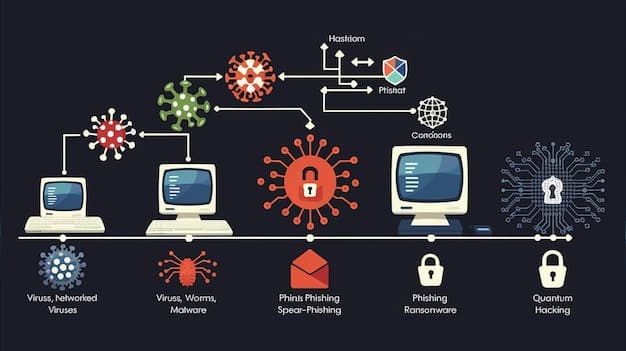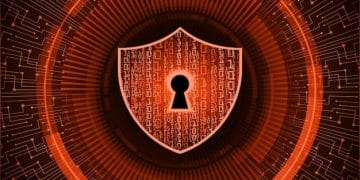How the US Government Responds to Cybersecurity Threats: Latest Strategies

How does the US government respond to cybersecurity threats? The US government employs a multi-layered approach, including legislation, agencies like CISA and the FBI, and international cooperation, to protect national infrastructure and data from cyberattacks. Latest strategies involve proactive threat hunting, AI, and public-private partnerships.
In an increasingly digital world, cybersecurity threats are a constant and evolving challenge. Understanding how does the US government respond to cybersecurity threats is crucial for safeguarding national security, economy, and public trust. The government’s approach involves a complex framework of agencies, policies, and strategies designed to detect, prevent, and respond to cyberattacks.
Understanding the Landscape: US Cybersecurity Threats
The digital age has brought unprecedented connectivity and opportunities, but also a surge in cybersecurity threats. These threats range from individual hackers to sophisticated state-sponsored actors, each with their own motivations and capabilities. Understanding the nature of these threats is the first step in developing effective countermeasures.
Types of Cybersecurity Threats
The US government faces a variety of cybersecurity threats that can compromise sensitive information and disrupt critical infrastructure. Different types of threats require different strategies.
- Malware and Ransomware: Malicious software designed to infiltrate systems, steal data, or hold it hostage for ransom.
- Phishing and Social Engineering: Deceptive tactics used to trick individuals into divulging sensitive information.
- Distributed Denial-of-Service (DDoS) Attacks: Overwhelming a system with traffic to render it unavailable.
- State-Sponsored Attacks: Cyber operations conducted by foreign governments to gain strategic advantages.

These threats constantly evolve, so how does the US government respond to cybersecurity threats? It needs to stay agile and adapt its defense mechanisms to stay ahead of these challenges.
The US Government’s Cybersecurity Framework
To effectively combat cyber threats, the US government has established a comprehensive framework that includes legislative measures, key agencies, and various strategic initiatives. This framework is designed to protect both government and private-sector entities from cyberattacks.
Key Legislative Measures
Several laws and regulations form the backbone of the US government’s cybersecurity efforts. These laws provide the legal authority and framework for cybersecurity activities.
- The Cybersecurity Information Sharing Act (CISA): Encourages the sharing of threat information between the government and private sector.
- The Federal Information Security Modernization Act (FISMA): Requires federal agencies to develop and implement cybersecurity programs.
- The National Institute of Standards and Technology (NIST) Cybersecurity Framework: Provides a set of guidelines for organizations to manage and reduce cybersecurity risks.
These legislative measures provide the legal foundation for how does the US government respond to cybersecurity threats and establish a framework for cooperation and compliance.
Core Agencies and Their Roles
Numerous government agencies play critical roles in US cybersecurity efforts, each responsible for different aspects of threat detection, prevention, and response. Understanding their roles is essential to grasping the government’s overall strategy.
Key Agencies Fighting Cybercrime
Several agencies fight cybercrime on multiple fronts. They include agencies that focus on defense like the Department of Defense as well as the Department of Homeland Security. Below are a few key players in the fight against cybercrime:
- The Cybersecurity and Infrastructure Security Agency (CISA): Leads the nation’s efforts to understand, manage, and reduce cyber and infrastructure risks.
- The Federal Bureau of Investigation (FBI): Investigates cybercrimes and works to disrupt cyber threats.
- The National Security Agency (NSA): Focuses on intelligence gathering and cybersecurity for national security purposes.
- The Department of Defense (DoD): Protects military networks and assets from cyberattacks.
These agencies collaborate and coordinate their efforts to ensure a comprehensive and effective response to cybersecurity threats. How does the US government respond to cybersecurity threats? Through the collaboration of such agencies, the response becomes much more strong and effective.
Latest Strategies: Proactive and Adaptive Measures
In recent years, the US government has adopted more proactive and adaptive cybersecurity strategies to stay ahead of evolving threats. These strategies emphasize early detection, rapid response, and continuous improvement.

Threat Hunting and Incident Response
Threat hunting involves actively searching for cyber threats that may have evaded traditional security measures. Incident response focuses on quickly containing and mitigating the impact of cyberattacks.
- Continuous Monitoring: Real-time monitoring of networks and systems to detect suspicious activity.
- Vulnerability Assessments: Regularly assessing systems for vulnerabilities that could be exploited by attackers.
- Incident Response Plans: Developing and implementing plans to quickly respond to and recover from cyber incidents.
These proactive measures are crucial for minimizing the damage caused by cyberattacks. They are often put into place to address the question: How does the US government respond to cybersecurity threats?
Public-Private Partnerships in Cybersecurity
Recognizing that cybersecurity is a shared responsibility, the US government collaborates closely with the private sector to enhance cyber defenses. These partnerships enable the sharing of information, expertise, and resources.
Benefits of Collaboration
Public-private partnerships offer numerous benefits for improving cybersecurity. Through sharing information and working together, more effective cybercrime defenses can be created.
These partnerships enhance the ability of both the government and private sector to detect, prevent, and respond to cyber threats. This collaboration is another facet of addressing how does the US government respond to cybersecurity threats.
- Information Sharing: Sharing threat intelligence and best practices to improve situational awareness.
- Joint Exercises: Conducting joint cybersecurity exercises to test and improve incident response capabilities.
- Research and Development: Collaborating on research and development efforts to develop new cybersecurity technologies and strategies.
By working together, the government and private sector can create a more resilient and secure cyber ecosystem.
The Future of US Government Cybersecurity Strategies
As cyber threats continue to evolve, the US government must adapt its cybersecurity strategies to address new challenges. This includes leveraging emerging technologies, strengthening international cooperation, and enhancing cybersecurity education and training.
Emerging Technologies and Strategies
The US government is exploring and implementing several emerging technologies to bolster its cyber defenses. They include:
- Artificial Intelligence (AI) and Machine Learning (ML): Automating threat detection and response.
- Blockchain Technology: Enhancing the security and integrity of data.
- Zero Trust Architecture: Implementing security models based on the principle of “never trust, always verify.”
By embracing these technologies, the US government can enhance its ability to detect, prevent, and respond to cyber threats effectively. In the future, one of the key responses to the query ‘How does the US government respond to cybersecurity threats‘ will be ‘leveraging AI and machine learning’.
| Key Point | Brief Description |
|---|---|
| 🛡️ Cybersecurity Framework | Legislative measures & key agencies form a comprehensive defense. |
| 🤝 Public-Private Partnerships | Collaboration enhances threat detection & incident response. |
| 🤖 Emerging Tech | AI & Blockchain fortify cyber defenses. |
| 🌐 International Cooperation | Global collaboration crucial for countering cyber threats. |
Frequently Asked Questions
Key laws include the Cybersecurity Information Sharing Act (CISA) and the Federal Information Security Modernization Act (FISMA), which establish frameworks for information sharing and cybersecurity program implementation.
Major agencies include CISA, which leads national cyber and infrastructure risk management, the FBI, which investigates cybercrimes, and the NSA, focused on intelligence gathering for national security.
The government promotes public-private partnerships by encouraging information sharing, conducting joint exercises, and working together on research and development to tackle the evolving cybersecurity landscape.
Such collaboration result in sharing information and best practices to improve situational awareness, conduct joint cybersecurity exercises to test and improve incident response capabilities and allow collaboration on cybersecurity tech.
The U.S. government is exploring AI, machine learning, and blockchain technologies to automate threat detection, secure data, and implement zero-trust security architectures for better cybersecurity.
Conclusion
In conclusion, how does the US government respond to cybersecurity threats is multifaceted, involving legislative measures, agency coordination, proactive strategies, and public-private partnerships. These efforts are essential for protecting national security, economic stability, and public trust in an increasingly interconnected world. By staying vigilant and adaptive, the US government can effectively address the evolving challenges of cybersecurity.





